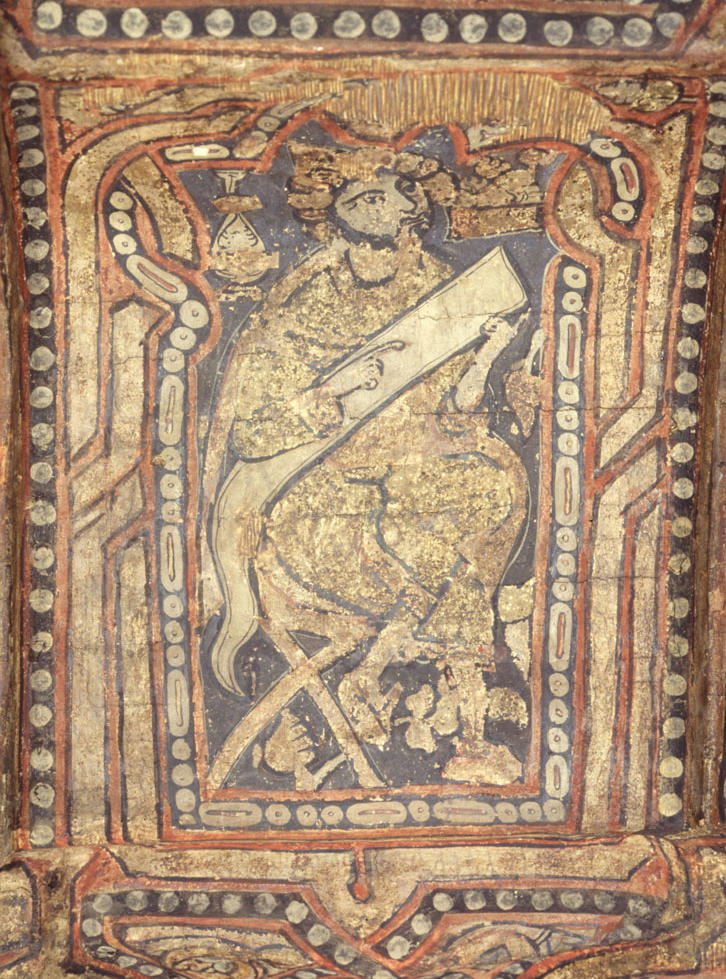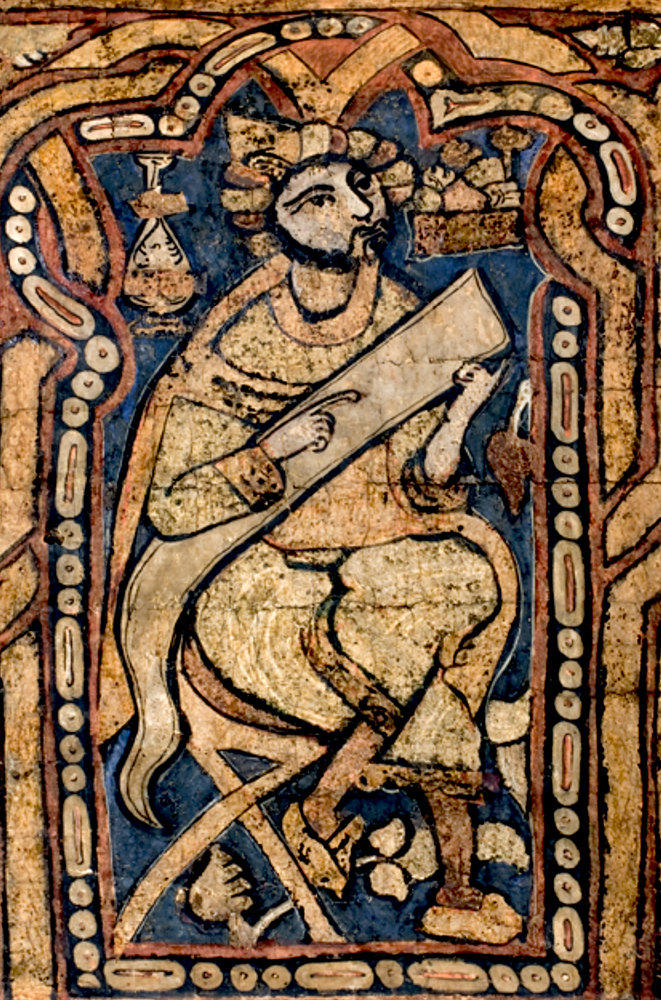Create an Amazon Wedding Registry Create an Amazon Business Account |
Arabic Scribe in The Painted Wooden Ceiling of the Palatine Chapel
Cappella Palatina
Palermo, Sicily
The Arabic Scribe before restoration ISL 14999 |
 |
Create an Amazon Wedding Registry Create an Amazon Business Account |
The Arabic Scribe before restoration ISL 14999 |
 |
[Continued from a Musician tuning a Triangular Psaltery. Cappella Palatina.]
In the same north-east corner unit, the large rectangular panel immediately to the north was painted by the same artist with the figure of a Scribe (Fig. 9).53 The bearded man wears a turban tied around a conical cap, a long robe adorned with gold bands ornamented in black, and very prominent shoes of exactly the same type as worn by the Musician tuning a Triangular Psaltery (Fig. 7). With his left leg crossed over his right knee, he too sits upon on a curule chair — the only other figure in the ceiling to do so. He holds with his left hand what appears to be a long scroll to which he points with the index finger of his right hand. Floating in the background behind his shoulders are a bottle and a tray laden with fruit. Foliate ornament is restricted to a few sprigs at the bottom of the panel, not least because of the tight confines imposed by the elaborate polylobed inner frame. Although the figure does not hold a pen he is usually identified as a Scribe because he adheres closely to the iconographic formula for the scribe in early Islamic art. While scribes as such are not often depicted, they are by no means unknown. The scribe in the famous birth-scene of the Schefer Maqāmāt, is shown as a bearded figure, wearing a turban, holding a long scroll in his left hand and a pen in his right; an almost identical scribe, seated on a stool, appears in the episode of Abū Zayd and his son in front of the cadi.54 In the other 13th-century Paris Maqāmāt, a scribe holds the long scroll in the shape of an inverted U that later can be seen to be a standard element of the iconographic formula.55 The figure of a scribe far more commonly represents the planet Mercury, al-ʿUṭārīd, known in Arabic also as al-Kātib, ‘the Scribe’, and thus drawn as a seated male figure holding either an open book or a long, U-shaped scroll, for example on a late-13th- or early-14th century metal basin from Mamlūk Egypt, and in the illustrations to later Arabic astronomical and astrological treatises, such as the famous manuscript of Abū Māʾshar al-Balkhī’s Kitāb al-Mawālid copied in Cairo in the 15th century.56
Perhaps the closest formal parallels for the Scribe in the Cappella Palatina come from Norman Sicily. One of the two notarii saraceni in Peter of Eboli’s famous illustration of the trilingual royal chancery is a bearded figure, wearing a turban and shoes, and with his left leg crossed over his right knee, writing on a long scroll.57 Less well known, in the painted beams from Cefalù Cathedral, a bearded and bareheaded figure, apparently seated, holds in his left hand a long scroll to which he points with his right hand, while a wine jug floats in the background.58 The artists of both these Sicilian images associated the scene with other images of royalty, so that there is some reason to identify the Scribe in the Cappella Palatina as a royal scribe, a symbol of Roger’s monarchy, and also, perhaps, as one of the ‘self-referential’ genre scenes in which the ceiling refers to the daily activities — in this case the administration — of the royal court and palace.59 The Cefalù Scribe was probably modelled directly upon the Scribe in the Cappella Palatina and so adheres to the conventional Islamic iconographic formula, while Peter of Eboli’s Scribe also seems to owe more than a little to the Islamic al-Kātib.
The artist responsible for this pair of adjacent panels in the north-east corner of Cappella Palatina was careful to establish a close visual connection between the Musician tuning a Triangular Psaltery and the Scribe: both scenes are enclosed by elaborate polylobed frames, both figures wear shoes, and both sit upon curule chairs (Fig. 7 and Fig. 9). That these two panels, one of which drew heavily upon a Romanesque model of King David tuning his Psaltery, form a pair in the midst of all the Solomonic references in the east end, leaves little room for doubt that one represents David the Harpist and the other his Scribe who records the words of the Psalms.60 This pairing of harpist and scribe (or scribes) is familiar, as King David and his Scribe(s), from many Romanesque illustrations of the revelation of the Psalms. For example, in the mid-9th century Psalter probably originally from St Remi at Sens, now in the Bibliothèque municipale at Angers (MS 0018), King David and one musician are illustrated on the left-hand page of an opening, opposite the page depicting three more musicians in the upper register and, below them, two seated scribes, both writing upon long scrolls (Fig. 10).61
54 Paris, Bibliothèque Nationale, MS Arabe 5847, respectively, fol. 122b and fol. 21a.
55 Paris, Bibliothèque Nationale, MS Arabe 3929, fol. 53a.
56 ... Metal basin: New York, Metropolitan Museum of Art, acc. no. 91.1.553 ... K. al-Mawālid: Paris, Bibliothèque Nationale, MS Arabe 2583, fols 4b, 5b (bis), 6b, 7b, 8b, 9b, 10b, 11b, 12b, 14b, 15b, 17b, 18b, 19b, 20b and 32b.
57 Peter of Eboli, Liber ad honorem Augusti, circa 1196. Bern, Burgerbibliothek, Codex 120 II, fol. 101a ...
61 L. Réau, Iconographie de l’art chrétien, 3 vols in 6 (Paris 1955– 58), II/i, 255–56, 263–64, 281–86; E. Kirschbaum et al., Lexikon der christlichen Ikonographie, 8 vols (Rome, Freiburg, Basel and Vienna 1968–76), I, cols 477–90, III, cols 466–81; Steger, David rex (as n. 52), 36, 40, 75, 77, 110, 120 and especially 155–57 cat. no. 3 and pl. 3 (London, British Library, MS Cotton Vespasian A I, fol. 30v: Psalter, Canterbury, mid-8th century), 160–62 cat. no. 7 (Angers, Bibliothèque municipale, MS 18, fols 13v–14r: Psalter, Sens, Abbey of St Remy, c. 842–50; see also Marchesin, L’image organum (as n. 52), illus. 10–11 and colour good image at <http://www.enluminures.culture.fr/> [accessed 3 May 2015]), 168–70 cat. no. 12 (Rome, San Paolo fuori le Mura, fol. 147v: Bible, Reims, 870–75), and 179–80 cat. no. 19 (Rome, Biblioteca Vaticana Cod. Lat. 82, fol. 12v, Bobbio (?), 10th century); Marchesin, L’image organum (as n. 52), illus. 16 (Munich, Bayerische Staatsbibliothek, Clm. MS 343, fol. 12v: Psalter, Milan, late-10th century); Grube and Johns, Painted ceilings (as n. 2), 141, figs 28.9–10, 148–50, figs 32.1–33.3; Kapitaikin, ‘Twelfth-century paintings’ (as n. 37), 256–58, misses the crucial point that the association of David the Psalmist with his scribe(s) belongs firmly within the Romanesque iconographic tradition.
Text source: Jeremy Johns, Muslim Artists and Christian Models in the Painted Ceilings of the Cappella Palatina